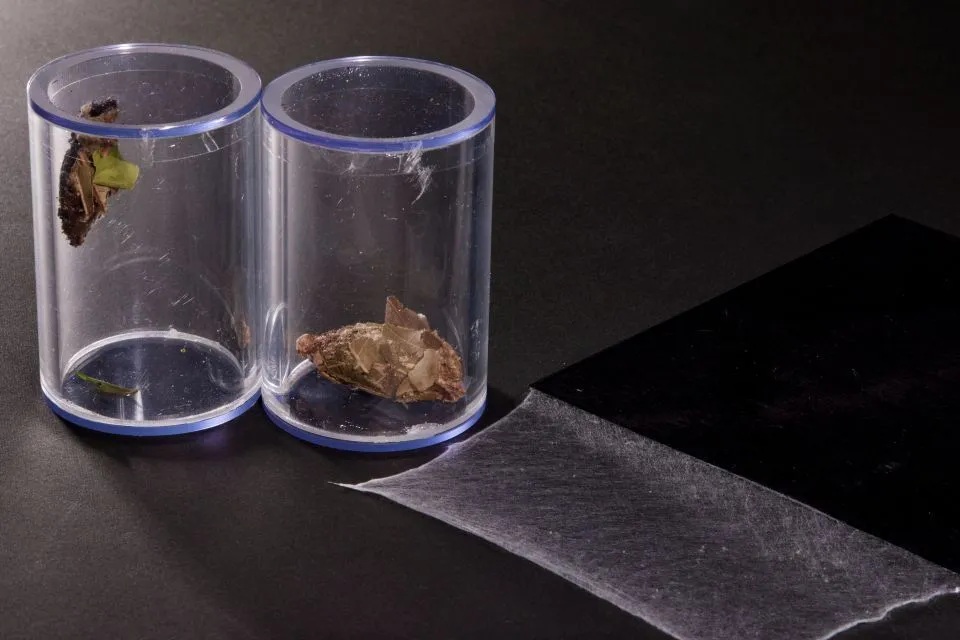
FPC at SGL site in Meitingen officially opened
Moth larvae’s silk surpasses spider silk in all indicators of durability.

29th July 2025
Innovation in Textiles
|
Japan
Until now, spider silk has laid claim to being the world’s strongest natural fibre, but in Japan, researchers are betting on the humble bagworm.
The strength of spider silk is four times that of steel, its elasticity rivals that of nylon and it can withstand temperatures exceeding 300°C. Spiders, however, have cannibalistic tendencies that make large-scale breeding for commercial applications extremely difficult.
Research by Japan’s National Agriculture and Food Research Organization (NARO) and Kowa, a manufacturer of pharmaceuticals and optical equipment that also imports and exports textiles, has now discovered that bagworm silk surpasses spider silk in all indicators of durability.
It has approximately 2.3 times greater toughness in terms of its flexibility to withstand deformation without breaking and about 1.8 times higher tensile strength. This research has already been published in the international scientific journal Nature Communications.
Some 1,000 bagworm species exist worldwide, about 50 of which are found in Japan. The giant bagworm – Eumeta variegata – is the most well-known species in Japan. Bagworms spin their own silk to bind fragments of leaves and twigs to form the nests they wrap themselves in, as well as to hang from branches for protection from predators and to move from place to place.
Ordered structure
“Bagworm silk is made of protein, just like silkworm and spider silk,” explains Asanuma Akimune, senior manager of Kowa’s Future Business Development Office. “When we analyzed the amino acid sequences that make up the protein, we found that it has a highly ordered hierarchical structure, which is what provides its high strength.”
To commercialise this potentially revolutionary natural fibre, Kowa has now established the Kowa Research Laboratories for Advanced Science in Tsukuba City, Ibaraki Prefecture, and commenced joint research with NARO on the artificial breeding of bagworms.

With no bagworm specialists on hand, team members initially spent their days collecting, breeding and observing bagworm behaviour. The first step towards industrial application came with the discovery of a breeding method that leverages the characteristics of the bagworm lifecycle. Whereas silkworms spin silk only for two or three days just before pupation, bagworms begin spinning silk immediately after birth and continue throughout their larval stage. The team then developed indoor breeding methods and established a system for continuous silk collection.
Foothold silk
Bagworms spin zigzag ladder-like silk threads and use them as scaffolding for their movement. Based on this ‘foothold silk’ Kowa has successfully created ultra-thin nonwoven fabric-like sheets at a rate of up to 1,000 square metres annually.
In November 2024, Kowa successfully commercialised bagworm silk for the first time with the launch of its Minolon brand.
The first product to utilise Minolon was a new series of Ezone tennis rackets by sports equipment manufacturer Yonex. Minolon was used in the racket shaft by fusing it with advanced carbon materials. With Minolon’s combination of strength and flexibility, the racket’s vibration damping performance improved by 5.8% compared to conventional products.
“Bagworm silk is made of protein and is biodegradable,” says Asanuma. “Since it’s not derived from fossil fuels, there’s no risk of it turning into microplastics after disposal or negatively impacting ecosystems. We currently use it in composites with plastic, but if we can eventually produce composites with bioplastics, we should be able to develop products with even lower environmental impact.”
Kowa is currently pursuing low-volume, high-value-added applications that make use of the special properties of bagworm silk. The company anticipates the development of applications in unexplored fields such as aerospace where the fibre’s strength can be employed to maximum effect.

Business intelligence for the fibre, textiles and apparel industries: technologies, innovations, markets, investments, trade policy, sourcing, strategy...
Find out more